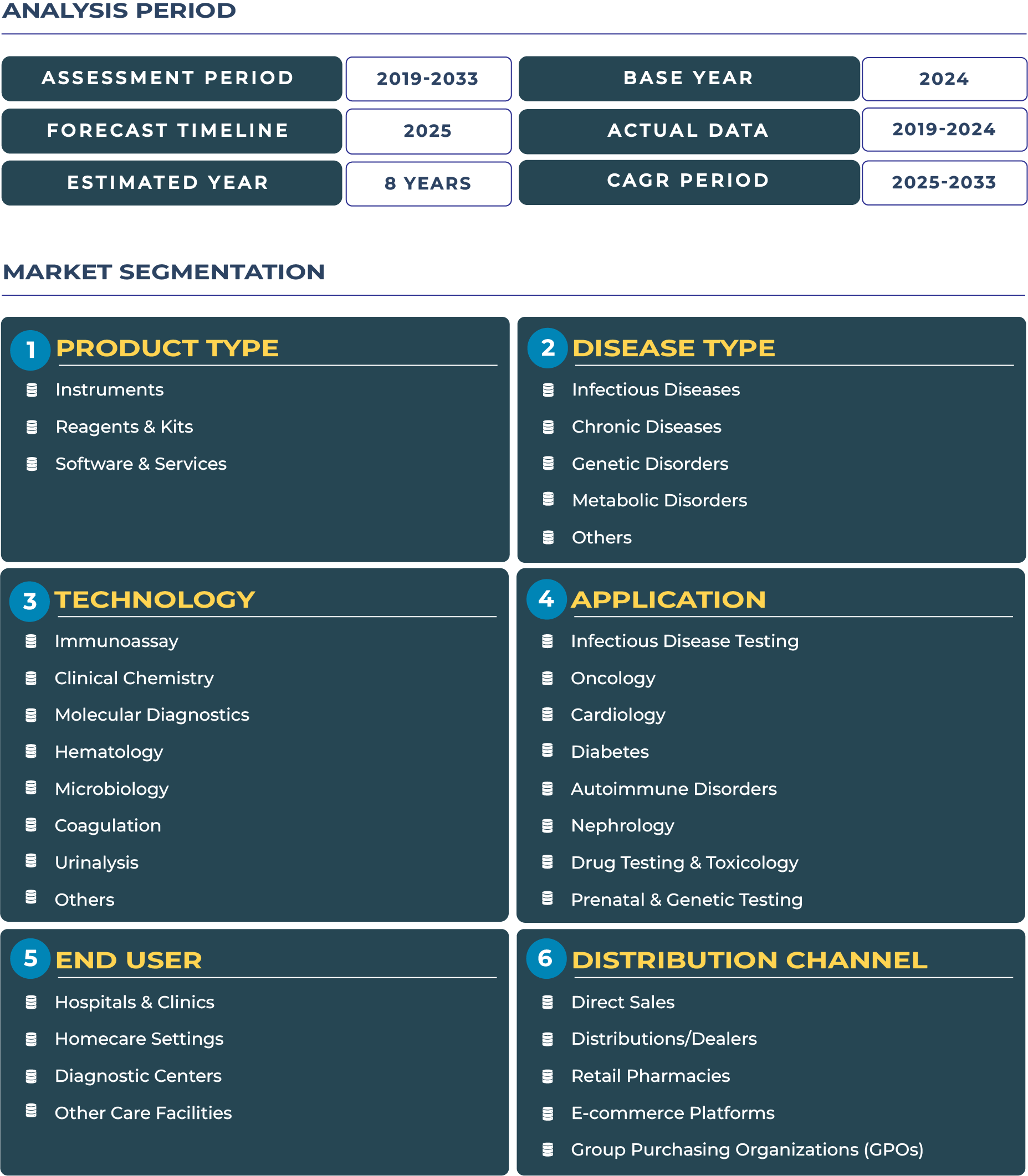Engineering Precision and Global Exports: Germany In-vitro Diagnostic Market Outlook 2025–2033
Germany’s reputation for engineering precision and medical innovation has positioned it at the forefront of the global in-vitro diagnostic (IVD) industry. The nation’s IVD sector thrives on its strong base in biomedical engineering, robust manufacturing standards, and a dynamic export-oriented economy. In 2025, the Germany In-vitro Diagnostic Market is valued at USD 5.82 billion and is projected to reach USD 7.84 billion by 2033. This growth trajectory is supported by Germany’s sustained investment in precision engineering, automation technologies, and continuous innovation in reagent and diagnostic instrument manufacturing. The market’s engineering excellence and export strength reinforce Germany’s global competitiveness in the IVD sector.
Germany IVD ecosystem has long benefited from its robust healthcare infrastructure, supported by institutions like the Federal Ministry of Health (BMG), which facilitates strategic health innovation and public-private collaboration. Moreover, leading companies are investing in digital diagnostic platforms, integrating AI-based image analysis, and streamlining reagent and kit production to address both domestic and international demand. The growing focus on diagnostic exports, coupled with Germany’s precision manufacturing ethos, is propelling the country to remain a leading hub in the European IVD landscape.
Dynamic Drivers Fueling Market Expansion Across Germany Diagnostic Ecosystem
The growth of the Germany IVD market is driven by several synergistic factors. Firstly, Germany’s large hospital and specialist base supports the adoption of advanced diagnostic instruments and software. The country hosts over 1,900 hospitals and thousands of diagnostic laboratories, many equipped with automated analyzers and advanced molecular testing systems. The increasing demand for reagents and testing kits for infectious diseases and chronic conditions has further expanded market depth.
Another strong driver lies in Germany’s extensive healthcare expenditure, representing nearly 12.7% of GDP, among the highest in Europe. High procedure volumes, precision medicine programs, and reimbursement coverage for diagnostic testing foster strong market momentum. In addition, the country’s established export networks ensure that IVD manufacturers can leverage both EU and non-EU markets effectively. Companies are also investing heavily in software and services that connect laboratories through cloud-based platforms, improving operational efficiency and patient outcomes.
Challenges of Procurement and Pricing Pressures in a Federally Structured System
Despite the positive outlook, the market faces structural challenges. The decentralized healthcare procurement model , where Laender (federal states) independently manage hospital budgets , often leads to delays in technology adoption and varied reimbursement rates. Price pressures from sickness funds, stringent approval processes, and competitive tendering reduce margins for diagnostic equipment suppliers.
Moreover, federal procurement complexities make it challenging for smaller IVD companies to penetrate hospital systems without established regional networks. Importantly, the rising cost of raw materials and supply chain disruptions linked to geopolitical tensions, including the Russia-Ukraine war, have added new layers of complexity to pricing strategies. As a result, while innovation remains strong, profitability pressures persist, compelling firms to optimize regional distribution and service strategies.
Emerging Trends and Opportunities Transforming Germany Diagnostic Landscape
Germany IVD market is undergoing a structural transformation through the integration of automation, robotics, and data-driven diagnostic models. The uptake of robotic systems in private hospitals and high-throughput diagnostic centers is enhancing laboratory efficiency and accuracy. Additionally, the rise of specialist clinics focusing on oncology, cardiology, and genetic disorders is increasing the demand for advanced diagnostic instruments and digital pathology solutions.
Private health insurance penetration is rising, particularly in affluent urban regions such as Munich, Frankfurt, and Hamburg, fueling higher spending on personalized diagnostic services. These trends are supported by national initiatives promoting early disease detection and patient-centric diagnostics. The market is also witnessing emerging opportunities in regional distributor alliances and KOL-led clinical rollouts. Local representatives are playing a pivotal role in deploying premium diagnostic lines and facilitating clinician education, strengthening adoption across both public and private sectors.
Competitive Landscape: Strategic Collaborations and Innovation-led Growth
Germany IVD industry is characterized by the presence of both domestic innovators and international leaders. Companies like Siemens Healthineers, headquartered in Erlangen, remain instrumental in shaping diagnostic innovation through their automation, molecular testing, and point-of-care technologies. The company’s continuous investment in R&D and digital diagnostics, including the use of connected platforms, positions it as a key pillar of the market’s technological transformation.
Several local companies are deploying regional specialist teams to support Laender-level procurement and clinician advocacy, while others are sponsoring specialized diagnostic training centers. Leasing models for high-end diagnostic instruments are becoming popular, especially among smaller hospitals and clinics. Recent collaborations between diagnostic manufacturers and academic institutions have led to advancements in multiplex assays and real-time PCR technologies, further boosting Germany’s diagnostic excellence.
Overall, the market’s competitive fabric reflects a mature but evolving ecosystem , one that leverages precision engineering, strong R&D capabilities, and export orientation to sustain long-term growth and innovation.







